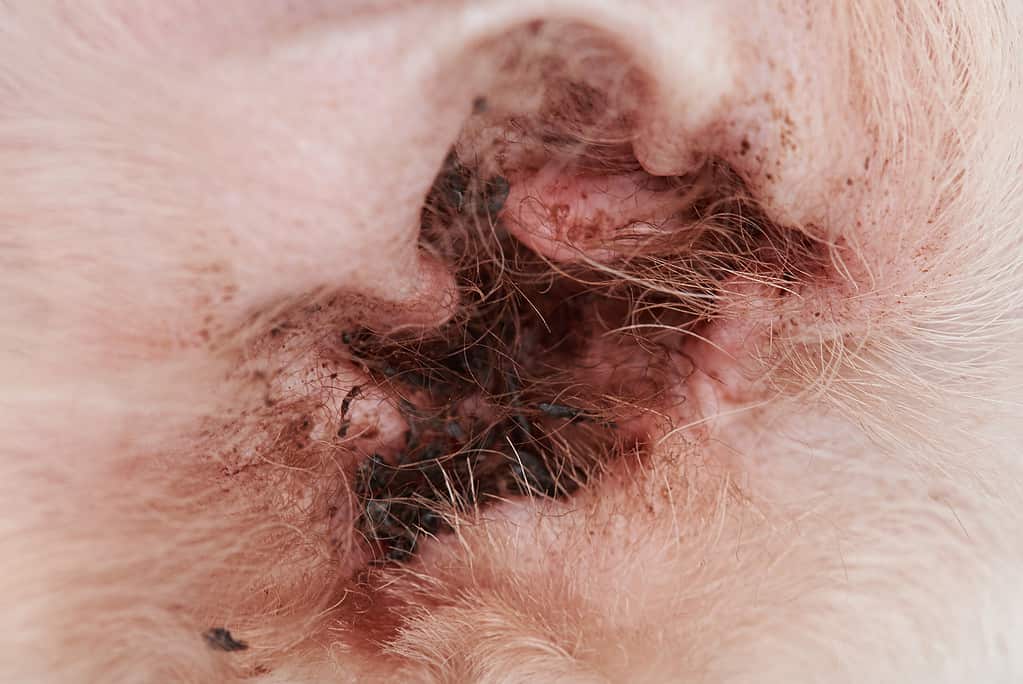Australian terriers are a small, rugged dog breed established by crossbreeding different British terriers. Settlers needed sturdy dogs to hunt down and capture rodents in mines, on ranches, and on farms, but those dogs also needed to tolerate the country’s harsh environments. The new breed fit into small areas and excelled at digging, which made it easy for them to catch mice, rats, and other vermin. This mix of breeds minimized the chances of Australian terrier health problems and concerns from happening.
This mix of breeds helps limit major health issues, but there are still some problems. Take a closer look at seven common health problems facing Australian terriers.
Diabetes Mellitus

Dogs with diabetes often drink excessive amounts of water.
©Jaromir Chalabala/Shutterstock.com
Australian terriers’ diabetes risk is 32 times higher than other dogs. Is your dog always thirsty and frequently needing bathroom breaks? Those are early indicators of diabetes.
What causes diabetes in dogs? A dog’s cells require energy to grow, heal, and work effectively, and glucose provides that energy. The pancreas produces insulin, a hormone that regulates glucose levels. When your dog eats, the sugars in that food pass through the intestines where they collect in the intestine’s cellular walls and convert to glucose. The body releases insulin to help carry that glucose around the body.
When insulin levels are insufficient, too much glucose collects in the bloodstream and ends up in the urine where it draws water to help flush it out. Your dog drinks more to make up for the excess water that helps expel the excess glucose from the body.
What can you do to prevent diabetes in Australian terriers? Keep your pet at a healthy weight. If your dog is obese, work with your pet’s veterinarian and establish a safe weight loss plan. Make sure your dog gets daily exercise through play and walks outside.
Weight loss is another common sign of diabetes. If your dog loses weight without dietary changes or increased exercise, make sure your dog sees a vet ASAP. Other signs of diabetes are:
- Cloudy eyes
- Lack of appetite
- Repeat infections
Diabetes requires routine blood tests, a high-fiber diet, and regular exercise. Establish a routine where your dog goes for brisk walks or plays in a fenced yard multiple times per day.
Eye Disease

Puppies are prone to hereditary retinal dysplasia, an abnormally structured retina.
©boitano/Shutterstock.com
Australian terrier eye conditions are another concern. One of them affects puppies, so pet owners should ask a breeder about the mother and father’s genetic histories.
Keratoconjunctivitis Sicca (KCS)
Keratoconjunctivitis sicca (KCS) isn’t as alarming as it sounds, it’s simply the condition known as dry eye. A dog with KCS isn’t producing enough tears so the eyes become too dry. A healthy eye produces a mixture of mucus, fatty acids, and water to keep the cornea lubricated. If this doesn’t happen, the cornea and other eye tissues become irritated and inflamed. Signs of KCS include:
- Cloudy eyes
- Frequent blinking or shutting the eyes
- Irritated, red eyes
- Thick eye discharge
If your Australian terrier has this common eye health issue, prescription eye drops help increase tear production. Keeping the area around the eyes clean helps lower the risk of eye infections.
Retinal Dysplasia
Retinal Dysplasia is a genetic condition caused by a deformed retina that’s common in several breeds, including English springer spaniels and Australian terriers. It can also occur due to neonatal infections like parvovirus. If a puppy has it, it’s often diagnosed in the sixth to eighth week of life.
Avoid retinal dysplasia by ensuring the mother stays healthy throughout her pregnancy. Check that the breeder’s dogs have no history of the eye condition. When you bring your puppy for a six-month wellness check, ask the veterinarian to check the eyes as a precaution.
If your puppy has retinal dysplasia, mild vision impairment is possible. An affected dog bumps into things or moves slowly and with hesitation. Typically, dogs use their other senses, like hearing and smelling, to overcome any difficulty, but you need to make sure your vision-impaired puppy has a safe place to roam.
Musculoskeletal Issues

Australian terriers love to run, but they’re prone to two joint conditions that increase the risk of lameness.
©BIGANDT.COM/Shutterstock.com
A dog’s muscles, joints, ligaments, tendons, and bones make up the musculoskeletal system. Australian terriers face a higher risk of developing these two musculoskeletal health issues.
Legg-Calve-Perthes Disease (LCP)
Legg-Calve-Perthes Disease (LCP) is a hip joint disorder found commonly in small breeds. It occurs when the blood supply to the femoral head slows or stops, leading to cellular death. A cycle of normal and slowed blood flow continues leading to bone fractures, new growth, and more fractures. Eventually, pain and stiffness limit mobility.
There’s no cure, which is why breeders are advised to have bone radiographs of both parents completed before breeding. If your Australian terrier has LCP, medications help with pain and inflammation. When a dog refuses to use an affected limb, joint replacement surgery is the best option.
Luxating Patella
A dog’s knee cap is located in a tendon within the thigh. While it should sit within a groove on the femur, some dogs experience problems where the knee cap shifts out of position. Patella luxation is a problem in 7% of puppies and is especially common in small terriers.
Sudden lameness is a key indicator of luxating patella. If your terrier frequently shakes a leg or doesn’t use a leg for a few steps, see a vet. Most dogs heal with rest, but severe cases can require surgery.
Obesity

Encourage your Australian terrier to get up and play as much as possible to avoid obesity.
©Ketterechts / CC BY-SA 4.0 – License
Any dog is likely to become obese if a pet owner isn’t careful, and Australian terriers are no different. The AKC breed standard recommends a weight of 15 to 20 pounds.
As tempting as it is to pamper your dog with yummy treats, an overweight dog is at a higher risk for pancreatitis, heart disease, diabetes, and joint pain. As your dog’s age and health changes, dietary adjustments become necessary.
Because of increased Australian terrier joint health conditions, owners must watch what and how much they feel their dog. Instead of food treats, provide extra playtime or cuddles as a reward. When you can’t resist, aim for healthier snacks like a piece of raw broccoli.
Skin Allergies

Australian terrier health problems include allergies, and those allergies can cause ear infections.
©dimarik/iStock via Getty Images
The last entry on our list of Australian terrier health problems and concerns is skin allergies. While the breed’s coat withstands mud and dirt, these terriers do experience skin allergies with itchy, inflamed skin. The belly, ears, and feet are more likely to become problem areas.
This type of skin allergy is called atopic dermatitis, and you may find it flares up when pollen counts are high. Keeping your dog out of tall grass may help, but it’s often difficult to determine what exact pollen is causing skin allergies. Ask your vet about allergy medications or topical ointments to help with the itching and inflammation.
Because Australian terriers have a high risk of developing infections, address any sores that develop from the constant chewing, scratching, and licking. While you keep them disinfected and apply recommended topical medications, use a cone to keep your pet from reaching those areas.
Australian Terrier Lifespan
On average, Australian terriers have a life span of 11 to 15 years. Keeping your dog happy and healthy goes a long way to helping your dog reach or exceed that average age.
Familiarize yourself with the eight common Australian terrier health problems and concerns. Get to know the early signs and alert your dog’s veterinarian to any changes. The sooner you address health issues, the better it is for your dog. Finally, know how often you should walk your dog and get outside each day for those walks.
The photo featured at the top of this post is © Bigandt_Photography/ via Canva.com
Ready to discover the top 10 cutest dog breeds in the entire world?
How about the fastest dogs, the largest dogs and those that are -- quite frankly -- just the kindest dogs on the planet? Each day, AZ Animals sends out lists just like this to our thousands of email subscribers. And the best part? It's FREE. Join today by entering your email below.
Thank you for reading! Have some feedback for us? Contact the AZ Animals editorial team.






